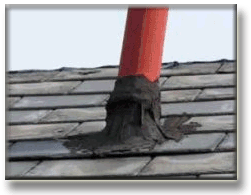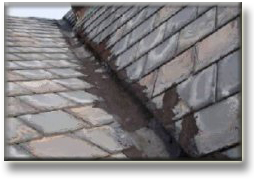-Tinknocker
Cedar Acid Rots and Deteriorates Copper
[ add comment ] ( 109 views ) | [ 0 trackbacks ] | permalink | related link |




 ( 2.6 / 19 )
( 2.6 / 19 )Slate, Tile & Cedar Roof Repairs by Novices Can Cost You
It is the constant peeve of the old world craftsman to see the new crop of novices every year that crawl upon good and sound repairable roofs and slather them with roof cement and caulk. It would provide some solace if these efforts worked to cure leaking situations on these natural roofs of old.

The truth is what we know as “muck” can actually cause a simple leak to become many profusely squirting leaks. Especially if used in a valley where water velocity demands a clear path. Muck creates obstacles for the water flow.

So instead, within the subject roof’s open valleys where a flowing stream should be, a run of raging rapids appear upon a subsequent rain event, squirting water under the courses laterally to enter the living area in several places. The muck dries and creates fissures that sends water in all directions. Like your finger on the end of a water hose, water sprays everywhere.
Slate, Tile and Cedar roofs are not that complex to understand. Cedar roofing has its own set of issues with new growth vs. old growth and repairs are more often than not out of the question. More on this will be discussed in future postings. Dismantling the natural stone and tile roofing is fairly easy to comprehend, but certain scaffolding and retrofitting skill is necessary.
Metal valleys that are leaking usually need to be replaced. If a slate roof still has life, replacing a valley is routine for a professional. Tile roofs often require the same attention. Tile roofs will last the longest of all the sloped systems. Tile was made from terra-cotta, ceramic and even concrete. All last a very long time, outlasting the flashings and valley linings.
The metal was often terne coated steel and sometimes copper. The latter was more expensive, but also vulnerable to the sulfur laden anthracite coal soot. The steel lasted longer then copper in some cases. The environment really dictated the longevity of the flashings. Note: We will be posting information regarding copper and cedar roofing (We did post a page with information regarding the improper use of copper flashings on cedar roofs and the damaging effects of cedar run-off acids on copper flashings.). We are noticing a trend where copper flashings are being used on cedar roofs - BIG NO NO. Old world craftsmen knew about this but many newcomers seem to be ignorant to the fact that cedar runoff degrades copper. We do have information on our website regarding this issue.
Nails were copper, tin, coated steel and galvanized steel. Often the nails falter first and looking across the courses will usually give us a good idea as to the holding power of the original nails. Generally, the weight of the tile and slate roofs put a burden on the nails and when the nails are deteriorating, they finally break away at the stress. The heavy stone or tile will sag at the course lines. If the courses are sagging, the nails are giving way and the roof needs to be removed and reclaimed, if possible.
Yankee Gutters are often removed and plywood is used to cover them because of cost, in favor of a conventional gutter. This represents a real loss of historical architecture. The cost of relining a Yankee Gutter is a small price to pay for the value it will yield and the curb appeal the gutter and underlying cornice details deliver a constant historical and cultural statement to the community. These old systems are not something for the novice to maintain. Often they are destroyed by the application of muck to them and the surrounding roofing tiles or slates.

So the moral to the story is to make sure you choose a natural roofing expert to evaluate your roof. A professional will give you the right advice.
[ add comment ] ( 173 views ) | [ 0 trackbacks ] | permalink |




 ( 3 / 3599 )
( 3 / 3599 )
 Random Entry
Random Entry




